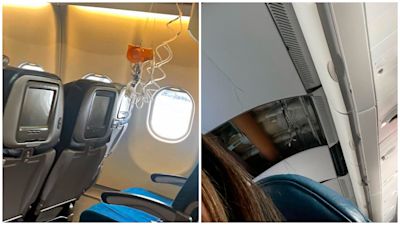Severe turbulence leaves 11 seriously injured on Hawaiian Airlines flight

A total of 36 people received treatment for cuts, including to the head, as well as bumps and bruises.
Eleven people have been seriously injured after severe turbulence rocked a Hawaiian Airlines flight.
The incident occurred shortly before the flight, which was carrying 278 passengers and 10 crew members, was due to land in Honolulu after taking off from Phoenix on Sunday.
Jon Snook, the airline's chief operating officer, said the airline hasn't experienced “an incident of this nature in recent history”.
A total of 36 people received treatment for cuts, including to the head, as well as bumps and bruises. Some people were nauseous and vomited as a result of extreme motion, officials said.
Of those injured, at least one person was reported to have been rendered unconscious but all patients were awake and talking when they arrived at hospitals, Jim Ireland, director of Honolulu Emergency Medical Services, said.
"We feel fortunate that there were not any deaths or other critical injuries. And we’re also very hopeful that all will recover and make a full recovery," Mr Ireland said.
Mr Snook said three flight attendants were among those taken to hospitals.
Passenger Kaylee Reyes told Hawaii News Now that her mother had just sat down when the turbulence hit and did not have a chance to buckle her safety belt.
“She flew up and hit the ceiling,” Reyes said.
There was some internal damage to the aircraft during the turbulence, Mr Snook said. The seatbelt sign was on at the time, though some of those injured weren't wearing them, he said.
Thomas Vaughan, a meteorologist with the National Weather Service in Honolulu, said there had been a weather advisory for thunderstorms that included Oahu and areas that would have included the flight path at the time of the incident.
The airline was aware of the weather forecast and the unstable air and weather conditions, but had no warning the particular patch of air where the turbulence occurred "was in any way dangerous,” Mr Snook said.
He didn't know how much altitude the plane lost during the turbulence, saying that would be part of an investigation involving the National Transportation Safety Board. The plane's flight data recorder would provide those details, he said.
The investigation would also address precisely what the passengers and crew were doing at the time, he added.
Want a quick and expert briefing on the biggest news stories? Listen to our latest podcasts to find out What You Need To Know
The Airbus A330-200 began its descent immediately after the turbulence and crew declared an emergency due to the number of injuries on board, he said. Air traffic controllers gave the flight priority to land.
The aircraft will undergo a thorough inspection and maintenance, mostly to fix components in the cabin, Mr Snook said.
He added he could only speculate whether some passengers hit their heads, but that was likely based on the injuries and the damage to cabin panelling.
“If you don’t have your seatbelt on, you stay where you are as the aircraft goes down and that’s how those injuries occur,” he said.
The investigation will examine what other measures were taken, aside from turning on the fasten seatbelt sign, to ensure passengers were buckled in, he said.
In 2019, 37 passengers and flight crew members were injured when an Air Canada flight from Vancouver to Sydney hit intense turbulence about two hours past Hawaii.
The Boeing 777-200 was diverted to Honolulu, where the injured received treatment. Thirty people were taken to hospitals and nine had serious injuries.
Most people associate turbulence with heavy storms. But the most dangerous type is so-called clear-air turbulence.
The wind-shear phenomenon can occur in wispy cirrus clouds or even clear air near thunderstorms, as differences in temperature and pressure create powerful currents of fast-moving air.
Planes can sail into clear-air turbulence without warning.